MYSQL压测
常用的mysql压测工具有两个
1、Mysql自带的压力测试工具——Mysqlslap
2、第三方工具sysbench进行压力测试
一、MySQL自带的压力测试工具——Mysqlslap
mysqlslap是mysql自带的基准测试工具,该工具查询数据,语法简单,灵活容易使用.该工具可以模拟多个客户端同时并发的向服务器发出查询更新,给出了性能测试数据而且提供了多种引擎的性能比较。mysqlslap为mysql性能优化前后提供了直观的验证依据,系统运维和DBA人员应该掌握一些常见的压力测试工具,才能准确的掌握线上数据库支撑的用户流量上限及其抗压性等问题。
1、更改其默认的最大连接数
再对mysql进行压力测试之前,需要更改其默认的最大连接数,
vim /etc/my.cnf
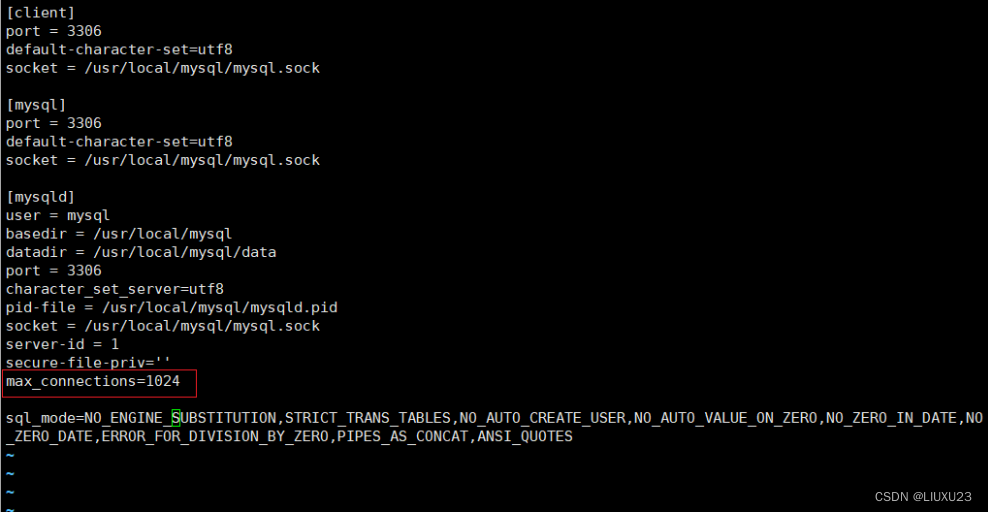
systemctl restart mysqld.service
进入mysql中查看最大连接数
进行压力测试
注意:mysqlslap好像会与default-character-set=utf8冲突
建议测试前先my.cnf文件中的default-character-set=utf8注释掉

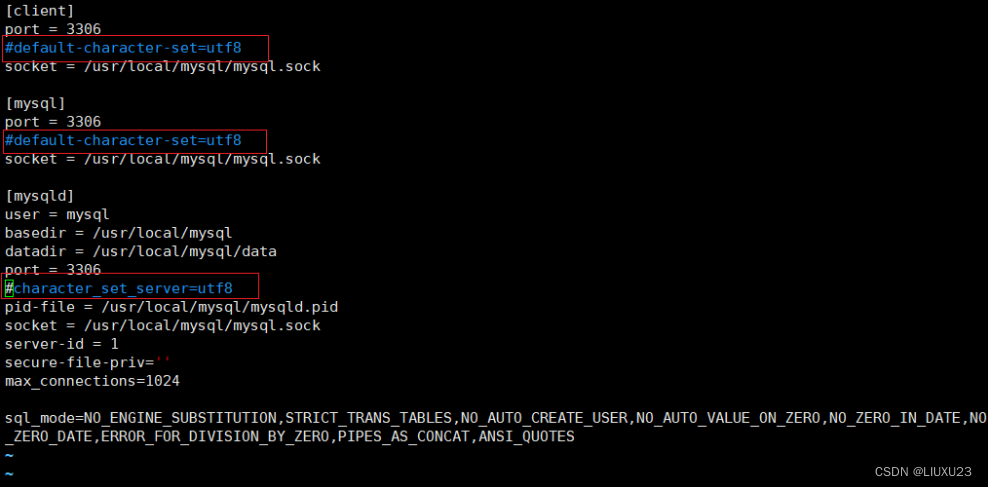
mysqlslap --defaults-file=/etc/my.cnf --concurrency=100,200 --iterations=1 --number-int-cols=20 --number-char-cols=30 --auto-generate-sql --auto-generate-sql-add-autoincrement --auto-generate-sql-load-type=mixed --engine=myisam,innodb --number-of-queries=2000 -uroot -pabc123 --verbose
#模拟测试两次读写并发,第一次100,第二次200,自动生成SQL脚本,测试表包含20个init字段,30个char字段,每次执行2000查询请求。测试引擎分别是myisam,innodb。
–defaults-file=/etc/my.cnf 从/etc/my.cnf文件中读取默认选项
–concurrency=100,200 测试并发的线程数/客户端数,第一次100,第二次200
–iterations=1 指定测试重复次数1次
–number-int-cols=20 指定测试表中int列的数量
–number-char-cols=30 指定测试表中varchar列的数量
–auto-generate-sql 自动生成 SQL 语句
–auto-generate-sql-add-autoincrement 在自动生成的表中添加自增列
–auto-generate-sql-load-type=mixed 测试的负载模型,包括 mixed, update, write, key,read,默认是 mix
–engine=myisam,innodb 指定建表时的存储引擎
–number-of-queries=2000 指定每个线程执行的 SQL 语句数量上限(不精确)
–verbose 更详细的输出
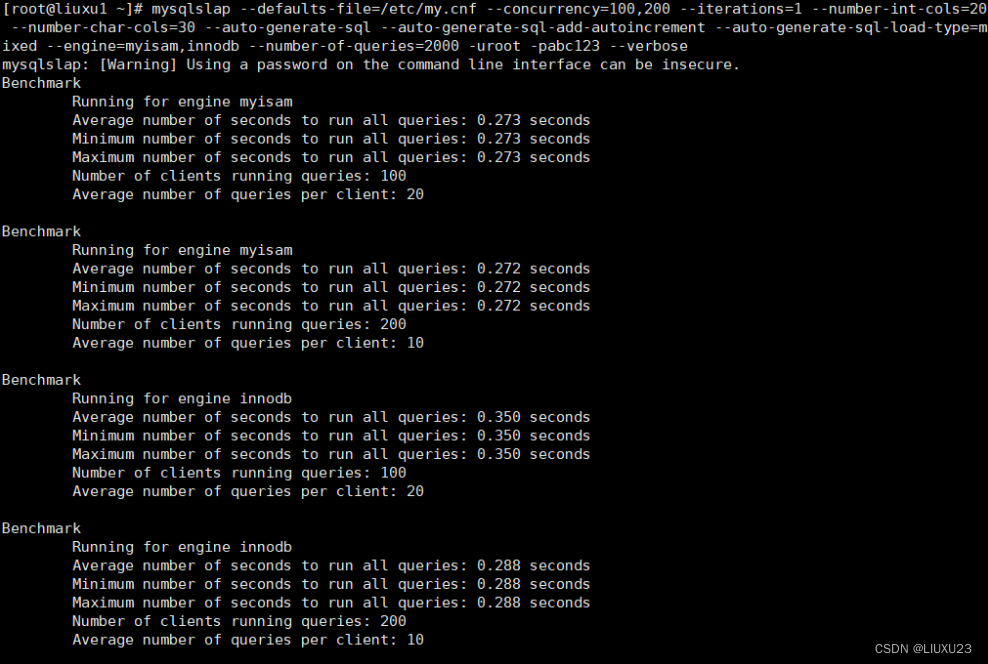
Average number of seconds to run all queries #运行所有查询的平均秒数
Minimum number of seconds to run all queries #运行所有查询所需的最小秒数
Maximum number of seconds to run all queries #运行所有查询的最大秒数
Number of clients running queries #运行查询的客户端数量
Average number of queries per client #每个客户端的平均查询数
看来这点压力不是问题,压力测试大胆一点
mysqlslap --defaults-file=/etc/my.cnf --concurrency=200,400 --iterations=1 --number-int-cols=50 --number-char-cols=60 --auto-generate-sql --auto-generate-sql-add-autoincrement --auto-generate-sql-load-type=mixed --engine=myisam,innodb --number-of-queries=80000 -uroot -pabc123 --verbose
压力调大测试,发现明显现在查询时间明显变慢了
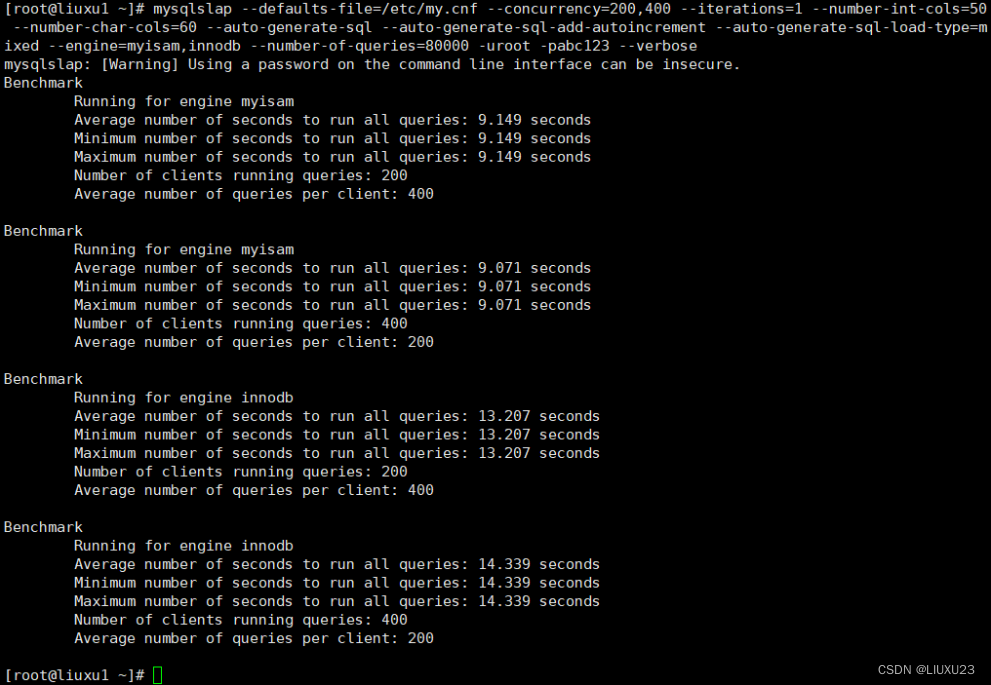
压力也不要调太大,会出现下面的场景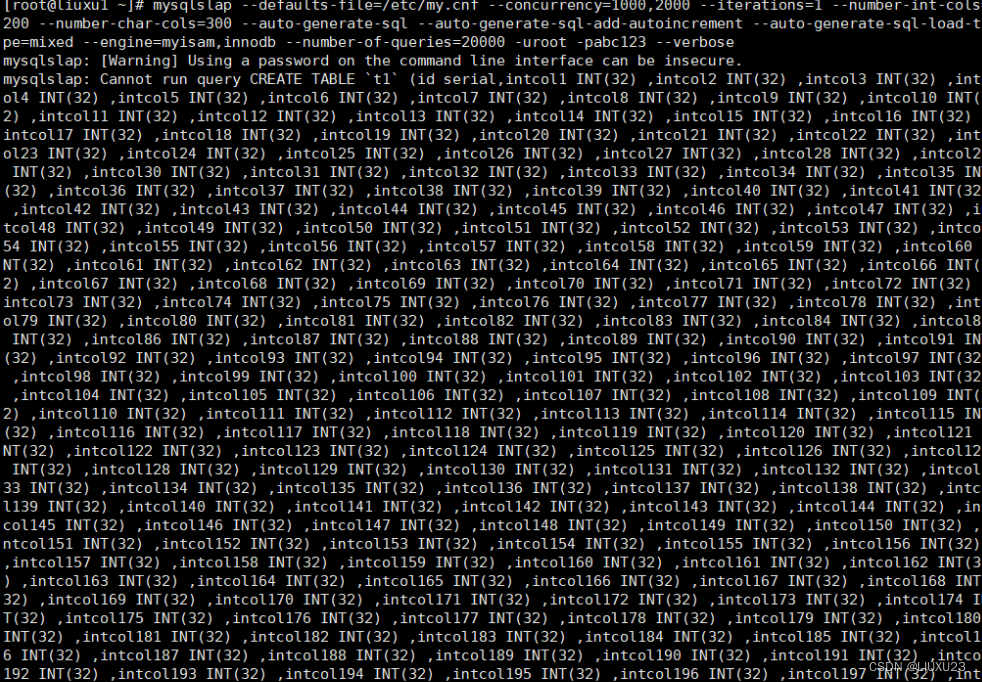
使用第三方工具sysbench进行压力测试
简介
系统平台/自述文件在硕士 ·阿科皮托夫/系统台 ·吉特哈布 (github.com)
https://github.com/akopytov/sysbench/blob/master/README.md#general-command-line-options
sysbench]是一款开源的多线程性能测试工具,可以执行CPU/内存/线程/IO/数据库等方面的性能测试。数据库目前支持MySQL/Oracle/PostgreSQL。本文只是简单演示一下几种测试的用法,后续准备利用sysbench来对MySQL进行一系列的测试。具体的一些参数设置,需要根据不同的测试要求来进行调整。
- CPU 运算性能测试
- 磁盘 IO 性能测试
- 调度程序性能测试
- 内存分配及传输速度测试
- POSIX 线程性能测试
- 数据库性能测试(OLTP 基准测试,需要通过 /usr/share/sysbench/ 目录中的 Lua 脚本执行,例如 oltp_read_only.lua 脚本执行只读测试)
- sysbench 还可以通过运行命令时指定自己的 Lua 脚本来自定义测试。
默认支持mysql
yum -y install epel-release #安装第三方epel源
yum -y install sysbench #安装sysbench工具
sysbench --version #确定工具已安装
sysbench 1.0.17
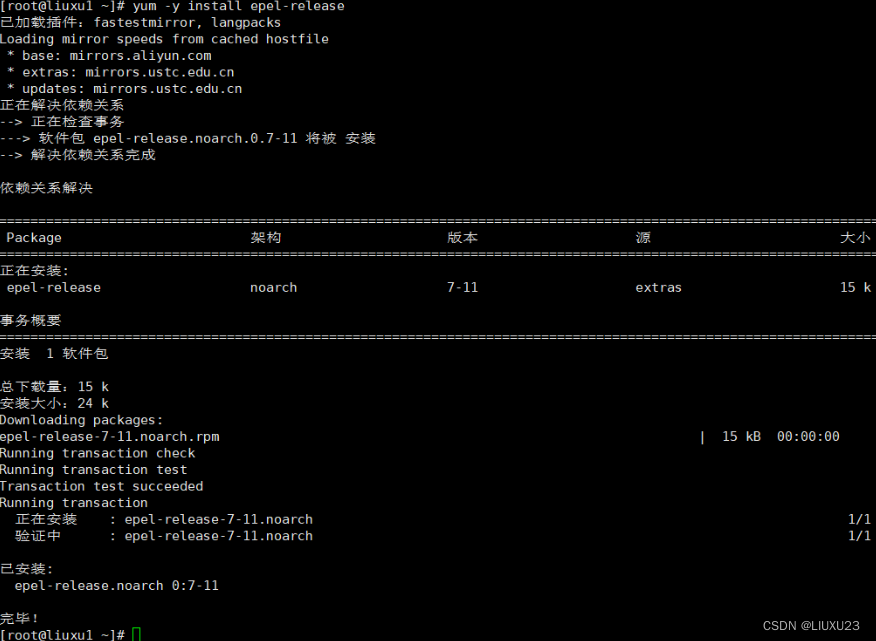


查看sysbench工具的帮助选项
- testname 是内置测试的可选名称(例如 ,,等),或捆绑的 Lua 脚本之一的名称(例如),或自定义 Lua 脚本的路径。如果在命令行上没有指定测试名称(因此,也没有命令,因为在这种情况下,它将被解析为测试名称),或者测试名称是破折号(“”),则 sysbench 期望 Lua 脚本在其标准输入上执行。
- command 是一个可选参数,它将通过系统平台传递到使用测试名称指定的内置测试或脚本。命令定义测试必须执行的操作。可用命令的列表取决于特定的测试。某些测试还实现自己的自定义命令。以下是对典型测试命令及其用途的描述:-
prepare:为那些需要它们的测试执行准备操作,例如,在磁盘上为测试创建必要的文件,或为数据库基准测试填充测试数据库。-run:运行使用测试名称参数指定的实际测试。此命令由所有测试提供。-cleanup:在创建临时数据的测试中,删除测试运行后的临时数据。-help:显示使用测试名参数指定的测试的用法信息。这包括测试提供的命令的完整列表,因此应使用它来获取可用命令。 - optiond是以 开头的零个或多个命令行选项的列表。与命令一样,该命令应用于描述特定测试提供的可用选项。有关 sysbench 本身提供的常规选项的说明,请参阅常规命令行选项。
可用于显示常规命令行语法和选项。
sysbench --help
[root@liuxu1 ~]# sysbench --help
Usage:
sysbench [options]... [testname] [command]
Commands implemented by most tests: prepare run cleanup help
General options: #普通功能
--threads=N 要使用的线程数,默认 1 个 [1]
--events=N 最大允许的事件个数 [0]
--time=N 最大的总执行时间,以秒为单位 [10]
--forced-shutdown=STRING 在 --time 时间限制到达后,强制关闭之前等待的秒数,默认“off”禁用
--thread-stack-size=SIZE 每个线程的堆栈大小 [64K]
--rate=N 平均传输速率。0 则无限制 [0]
--report-interval=N 以秒为单位定期报告具有指定间隔的中间统计信息 0 禁用中间报告 [0]
--report-checkpoints=[LIST,...] 转储完整的统计信息并在指定的时间点重置所有计数器。参数是一个逗号分隔的值列表,表示从测试开始经过这个时间量时必须执行报告检查点(以秒为单位)。报告检查点默认关闭。 []
--debug[=on|off] 打印更多 debug 信息 [off]
--validate[=on|off] 尽可能执行验证检查 [off]
--help[=on|off] 显示帮助信息并退出 [off]
--version[=on|off] 显示版本信息并退出 [off]
--config-file=FILENAME 包含命令行选项的文件
--tx-rate=N 已弃用——rate [0]的别名
--max-requests=N 已弃用 --events [0]的别名
--max-time=N 已弃用 --time [0]的别名
--num-threads=N 已弃用 --threads [1]的别名
Pseudo-Random Numbers Generator options: #伪随机数生成器选项
--rand-type=STRING 随机数分布 {uniform,gaussian,special,pareto} 默认使用[special]
--rand-spec-iter=N 生成数字的迭代次数[12]
--rand-spec-pct=N 被视为“特殊”(用于特殊分布)的值的百分比[1]
--rand-spec-res=N 使用的“特殊”值的百分比(用于特殊分布)[75]
--rand-seed=N 随机数生成器的种子。0时,当前时间作为RNG的种子。[0]
--rand-pareto-h=N pareto分布的参数h [0.2]
Log options: #日志选项
--verbosity=N verbosity level {5 - debug, 0 - only critical messages} [3]
--percentile=N percentile to calculate in latency statistics (1-100). Use the special value of 0 to disable percentile calculations [95]
--histogram[=on|off] print latency histogram in report [off]
General database options:
--db-driver=STRING specifies database driver to use ('help' to get list of available drivers) [mysql]
--db-ps-mode=STRING prepared statements usage mode {auto, disable} [auto]
--db-debug[=on|off] print database-specific debug information [off]
Compiled-in database drivers:
mysql - MySQL driver
pgsql - PostgreSQL driver
mysql options:
--mysql-host=[LIST,...] MySQL server host [localhost]
--mysql-port=[LIST,...] MySQL server port [3306]
--mysql-socket=[LIST,...] MySQL socket
--mysql-user=STRING MySQL user [sbtest]
--mysql-password=STRING MySQL password []
--mysql-db=STRING MySQL database name [sbtest]
--mysql-ssl[=on|off] use SSL connections, if available in the client library [off]
--mysql-ssl-cipher=STRING use specific cipher for SSL connections []
--mysql-compression[=on|off] use compression, if available in the client library [off]
--mysql-debug[=on|off] trace all client library calls [off]
--mysql-ignore-errors=[LIST,...] list of errors to ignore, or "all" [1213,1020,1205]
--mysql-dry-run[=on|off] Dry run, pretend that all MySQL client API calls are successful without executing them [off]
pgsql options:
--pgsql-host=STRING PostgreSQL server host [localhost]
--pgsql-port=N PostgreSQL server port [5432]
--pgsql-user=STRING PostgreSQL user [sbtest]
--pgsql-password=STRING PostgreSQL password []
--pgsql-db=STRING PostgreSQL database name [sbtest]
Compiled-in tests:
fileio - File I/O test
cpu - CPU performance test
memory - Memory functions speed test
threads - Threads subsystem performance test
mutex - Mutex performance test
See 'sysbench <testname> help' for a list of options for each test.
mysql options:
–mysql-host=[LIST,…] MySQL server host [localhost] #MySQL服务器主机
–mysql-port=[LIST,…] MySQL server port [3306] #MySQL服务器端口
–mysql-socket=[LIST,…] MySQL socket #MySQL的套接字
–mysql-user=STRING MySQL user [sbtest] #MySQL用户
–mysql-password=STRING MySQL password [] #MySQL密码
–mysql-db=STRING MySQL database name [sbtest] #MySQL数据库名称
–mysql-ssl[=on|off] use SSL connections, if available in the client library [off] #是否开启ssl连接
–mysql-ssl-cipher=STRING use specific cipher for SSL connections [] #对SSL连接使用特定的密码
–mysql-compression[=on|off] use compression, if available in the client library [off] #是否开启压缩功能
–mysql-debug[=on|off] trace all client library calls [off] #是否跟踪所有客户端库调用
–mysql-ignore-errors=[LIST,…] list of errors to ignore, or “all” [1213,1020,1205] #要忽略或“全部”的错误列表 --mysql-dry-run[=on|off] Dry run, pretend that all MySQL client API calls are successful without executing them [off] #模拟运行,假设所有的MySQL客户端API调用都是成功的,但没有执行它们
sysbench测试MySQL数据库性能
1、准备测试数据
#查看sysbench自带的lua脚本使用方法
sysbench /usr/share/sysbench/oltp_common.lua help
#必须创建sbtest库,sbtest事sysbench默认使用的库名
mysqladmin -uroot -pabc123 create sbtest;
#然后,准备测试所用的表,这些测试表放在测试库sbtest中。这里使用的lua脚本为/usr/share/sysbench/oltp_common.lua
sysbench --mysql-host=127.0.0.1 \
--mysql-port=3306 \
--mysql-user=root \
--mysql-password=abc123 \
/usr/share/sysbench/oltp_common.lua \
--tables=10 \
--table_size=100000 \
prepare
#其中--tables=10表示创建10个测试表,
#--table_size=100000表示每个表中插入10W行数据,
#prepare表示这是准备数的过程。
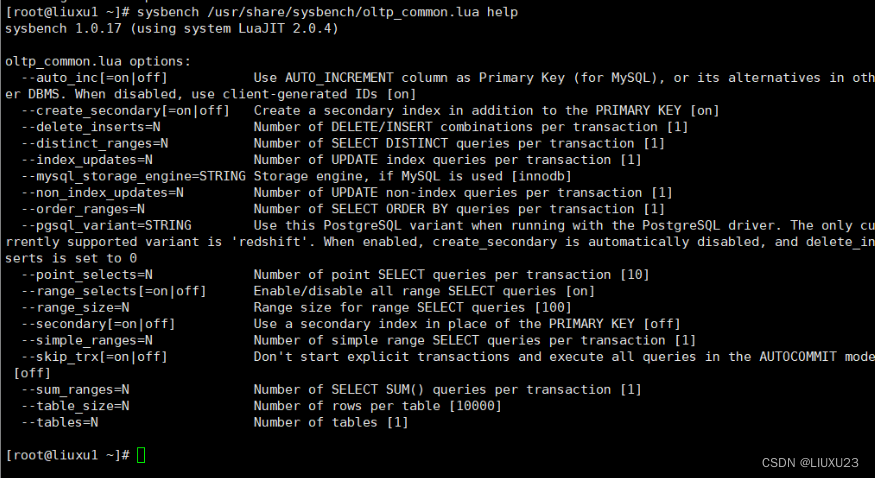
--auto_inc[=on|off] id列默认自增,默认[on]
--create_secondary[=on|off] 索引不是主键索引而是二级索引,默认[off]
--delete_inserts=N 每个事务的delete、insert的组合数,默认[1]
--distinct_ranges=N 单个事务中执行范围distinct查询的数量,默认[1]
--index_updates=N 单个事务中执行索引更新的操作的数量,默认[1]
--mysql_storage_engine=STRING mysql的存储引擎,默认是[innodb]
--non_index_updates=N 单个事务中执行索引更新的操作的数量,默认[1]
--order_ranges=N 单个事务中执行范围order by查询的数量,默认[1]
--pgsql_variant=STRING 在运行pgsql的驱动程序时,使用了pgsql的变体,当前仅仅支持的variant是'redshift',当启动时,将自动禁用create_secondary为不可用,并将delete_insert设置为0
--point_selects=N 单个事务中select查询的数量,默认 [10]
--range_selects[=on|off] 启用/禁用所有SELECT查询[on]
--secondary[=on|off] 使用二级索引代替逐渐,默认[off]
--range_size=N 查询范围。默认是100
--simple_ranges=N 每个事务的简单查询范围select,默认[1]
--skip_trx[=on|off] 语句以bigin/commit开始结尾,默认[off]
--sum_ranges=N 每个事务的select sum的查询总量,默认[1]
--table_size=N 指定表的记录大小(行的数量),默认[10000]
--tables=N 创建的表数量,默认[1]


sysbench --threads=4 \
--time=20 \
--report-interval=5 \
--mysql-host=127.0.0.1 \
--mysql-port=3306 \
--mysql-user=root \
--mysql-password=abc123 \
/usr/share/sysbench/oltp_read_write.lua \
--tables=100 \
--table_size=1000000 \
run

[root@liuxu1 ~]# sysbench --threads=4 \ #使用4个线程
> --time=20 \ #最大的总执行时间20秒
> --report-interval=5 \ #
> --mysql-host=127.0.0.1 \
> --mysql-port=3306 \
> --mysql-user=root \
> --mysql-password=abc123 \
> /usr/share/sysbench/oltp_read_write.lua \
> --tables=100 \
> --table_size=1000000 \
> run
sysbench 1.0.17 (using system LuaJIT 2.0.4)
Running the test with following options:
Number of threads: 4 #并发数4
Report intermediate results every 5 second(s) #每5秒报告一次测试结果
Initializing random number generator from current time
Initializing worker threads...
Threads started!
#下面是每5秒返回一次的结果,统计的指针包括:
线程数 thds 4
tps(每秒事务数)
qos(每秒查询数)
每秒的读/写/其他次数、延迟、每秒错误数、每秒重连次数
[ 5s ] thds: 4 tps: 253.12 qps: 5066.89 (r/w/o: 3547.34/1012.50/507.05) lat (ms,95%): 34.33 err/s: 0.00 reconn/s: 0
[ 10s ] thds: 4 tps: 335.20 qps: 6705.37 (r/w/o: 4693.58/1341.59/670.20) lat (ms,95%): 28.67 err/s: 0.00 reconn/s:
[ 15s ] thds: 4 tps: 343.27 qps: 6869.17 (r/w/o: 4809.56/1372.87/686.74) lat (ms,95%): 28.16 err/s: 0.00 reconn/s:
[ 20s ] thds: 4 tps: 336.91 qps: 6738.97 (r/w/o: 4716.72/1348.44/673.82) lat (ms,95%): 28.16 err/s: 0.00 reconn/s:
SQL statistics:
queries performed:
read: 88858 #执行的读操作数量
write: 25388 #执行的写操作数量
other: 12694 #执行的其它操作数量
total: 126940 #总执行的操作数量
transactions: 6347 (316.93 per sec.)#总事务数(每秒事务数)
queries: 126940 (6338.58 per sec.)#查询总数
ignored errors: 0 (0.00 per sec.)#忽略错误数
reconnects: 0 (0.00 per sec.)#重新连接数
General statistics:
total time: 20.0254s# 总消耗时间
total number of events: 6347 # 总请求数量(读、写、其它)
Latency (ms): #等待时间
min: 3.92 #最小耗时
avg: 12.60 #平均耗时
max: 61.54 #最长耗时
95th percentile: 29.72 #超过99%平均耗时
sum: 80002.95 #总时间
Threads fairness: #并发统计
events (avg/stddev): 1586.7500/6.26 #总处理事件数/标准偏差
execution time (avg/stddev): 20.0007/0.01 #平均处理事件时间/标准偏差
平均耗时
max: 61.54 #最长耗时
95th percentile: 29.72 #超过99%平均耗时
sum: 80002.95 #总时间
Threads fairness: #并发统计
events (avg/stddev): 1586.7500/6.26 #总处理事件数/标准偏差
execution time (avg/stddev): 20.0007/0.01 #平均处理事件时间/标准偏差
sysbench --threads=4
–time=20
–report-interval=5
–mysql-host=127.0.0.1
–mysql-port=3306
–mysql-user=root
–mysql-password=abc123
/usr/share/sysbench/oltp_read_write.lua
–tables=10
–table_size=100000
cleanup #删除刚刚的数据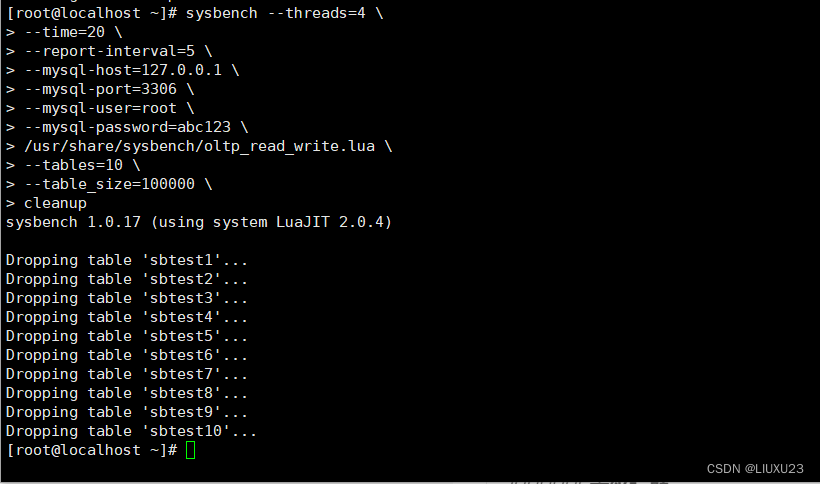
版权归原作者 LIUXU23 所有, 如有侵权,请联系我们删除。